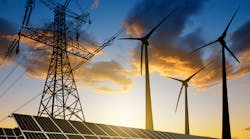Austrian Power Grid, Energy Web Foundation Launch Proof of Concept to Use DERs for Frequency Regulation
Last week, Austrian Power Grid AG and Energy Web Foundation announced the launch of a proof-of-concept process that will enable small-scale distributed energy resources (DERs) to participate in frequency regulation for the Austrian power grid. In the “Flex-Hub” concept, developed by APG, a number of open-source software applications from the Energy Web Decentralized Operating System (EW-DOS)—including Energy Web’s blockchain platform—will be utilized to efficiently streamline qualification and registration of providing units, bid management, and financial settlement functions for DERs under one umbrella.
APG is responsible for the real-time balancing of power generation and consumption to maintain a stable frequency within the Austrian grid at any time. Already since 2012, APG has been performing this task following a completely market-based approach.
APG has been a pioneer in the horizontal integration of the European regulating reserve markets. For example, APG founded a common market for Frequency Containment Reserves (FCR) with Switzerland in 2013, which has since been expanded to seven countries. Also in 2013, an Imbalance Netting Cooperation was initiated with Slovenia and later Croatia, and APG was one of the first transmission system operators (TSOs) to join the International Grid Control Cooperation with the same objective. This cooperation is now designated to be expanded to all of Europe.
Since 2016, APG has been cooperating with the German TSOs regarding the economic optimization of trans-border automatic Frequency Restoration Reserves (aFRR) activation. In December 2019, the first optimized manual Frequency Restoration Reserve (mFRR) activation took place between the two countries. In addition to joint activation, the TSOs of Austria and Germany are also planning coordinated procurement of FRRs to fulfill their balancing tasks in the most cost-effective way. The joint procurement of aFRR capacity is to start in February 2020.
However, the trend toward more and more decentralized generation of renewables and smart consumption units opens up new possibilities to utilize DERs to face the new grid challenges. Therefore, APG sees it as an absolute necessity to tap this potential for grid balancing, among other possibilities. In its role as innovator for market development, APG is determined to lead the way also in the vertical integration of the power markets. Therefore, APG developed the concept of a “Flex-Hub” for the utilization of distributed resources. Together with EWF, a first solution for its technical implementation will be developed as a proof of concept.
“We believe that fulfilling Austria’s goal of 100% renewable electricity until 2030 is achievable—if everyone at the table is committed to do what it takes. A huge piece of the puzzle will be the coordinated and standardized utilization of distributed flexibility potentials to efficiently integrate renewables into the electricity market. For this purpose, we need to develop the technical concepts for a ‘Flex-Hub,’ which can make these potentials accessible for all market participants, while respecting the constraints of the grid on all levels,” said Gerhard Christiner, CTO at APG.
Until now, small-scale generating and consuming units have not been directly connected to the wholesale electricity markets. EW-DOS offers an efficient, low-cost way to pre-qualify DERs for the market, to manage their participation in grid balancing processes, and to facilitate financial settlement for the grid services they ultimately provide. Although the current proof-of-concept process will include only a few providing units (e.g., residential lithium-ion batteries), APG expects that most of the roughly 1 million households in Austria will ultimately participate in the flexibility market via the “Flex-Hub,” which will eventually not only serve the flexibility needs of the TSO but of all market players.
The EW-DOS solution will enable DERs to use decentralized identifiers (DIDs) and a self-sovereign identity (SSI). In contrast to conventional centralized IoT cloud platforms, where a single central entity is responsible for maintaining an accurate catalog of all DERs, the EW-DOS approach allows customers to register their DERs directly, while accredited third parties such as installers can independently verify the details of any given unit (e.g., residential batteries).
In turn, requesters of flexibility resources can trust that bids from participating DERs are reliable and trustworthy without having to store too much information about the DERs themselves or the customers that own them. The distribution system operators keep a customer relationship with the DERs that are connected to their network even though an increasing number of them provide services for the electricity market to meet the demands of the electricity system of the future. Once DERs are dispatched, the EW-DOS solution allows for easy financial settlement.
The combination of blockchain-based and decentralized off-chain applications as well as conventional IT approaches set the intended proof-of-concept process apart from previous approaches and place Austria at the forefront of modern grid digitalization.
“We believe that such a decentralized approach that combines both cutting-edge technologies such as blockchain and tried-and-tested IT systems for grid operation is the future of power grids all over the world,” says Micha Roon, EWF’s chief technology officer. “We are proud to partner with such a progressive, forward-looking system operator as APG.”
Project teams of APG and EWF are currently designing modules for the solution. They are scheduled to unveil the proof of concept at the end of February.


